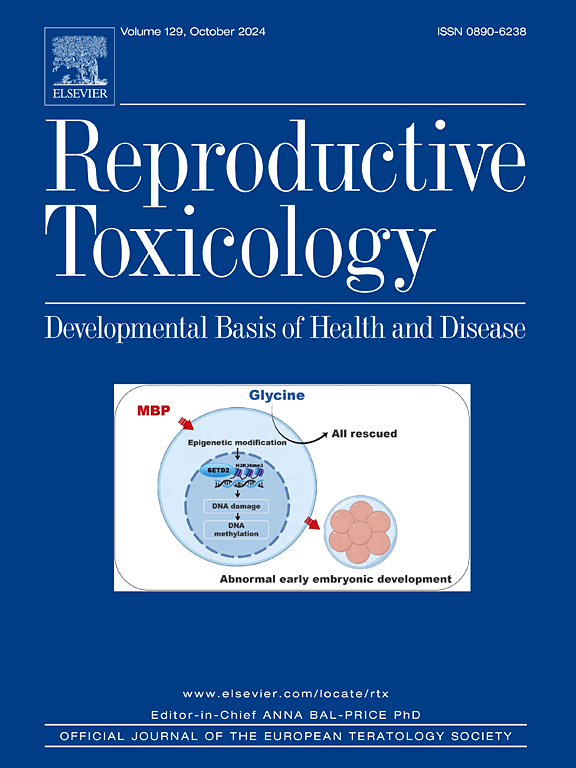Alcohol induces p53-mediated apoptosis in neural crest by stimulating an AMPK-mediated suppression of TORC1, S6K, and ribosomal biogenesis
IF 2.8
4区 医学
Q2 REPRODUCTIVE BIOLOGY
引用次数: 0
Abstract
Prenatal alcohol exposure is a leading cause of permanent neurodevelopmental disability and can feature distinctive craniofacial deficits that partly originate from the apoptotic deletion of craniofacial progenitors, a stem cell lineage called the neural crest (NC). We recently demonstrated that alcohol causes nucleolar stress in NC through its suppression of ribosome biogenesis (RBG) and this suppression is causative in their p53/MDM2-mediated apoptosis. Here, we show that this nucleolar stress originates from alcohol’s activation of AMPK, which suppresses TORC1 and the p70/S6K-mediated stimulation of RBG. Alcohol-exposed cells of the pluripotent, primary cranial NC line O9–1 were evaluated with respect to their S6K, TORC1, and AMPK activity. The functional impact of these signals with respect to RBG, p53, and apoptosis were assessed using gain-of-function constructs and small molecule mediators. Alcohol rapidly (<2 hr) increased pAMPK, pTSC2, and pRaptor, and reduced both total and pS6K in NC cells. These changes persisted for at least 12 hr to 18 hr following alcohol exposure. Attenuation of these signals via gain- or loss-of-function approaches that targeted AMPK, S6K, or TORC1 prevented alcohol’s suppression of rRNA synthesis and the induction of p53-stimulated apoptosis. We conclude that alcohol induces ribosome dysbiogenesis and activates their p53/MDM2-mediated apoptosis via its activation of pAMPK, which in turn activates TSC2 and Raptor to suppress the TORC1/S6K-mediated promotion of ribosome biogenesis. This represents a novel mechanism underlying alcohol’s neurotoxicity and is consistent with findings that TORC1/S6K networks are critical for cranial NC survival.
酒精通过刺激 AMPK 介导的对 TORC1、S6K 和核糖体生物生成的抑制,诱导 p53 介导的神经嵴凋亡。
产前酒精暴露是导致永久性神经发育障碍的主要原因之一,并可能导致独特的颅面缺陷,其部分原因是颅面祖细胞(一种称为神经嵴(NC)的干细胞系)的凋亡性缺失。我们最近证明,酒精通过抑制核糖体生物生成(RBG)导致NC细胞核极应激,而这种抑制是p53/MDM2介导的细胞凋亡的原因。在这里,我们发现这种核极应激源于酒精对 AMPK 的激活,AMPK 可抑制 TORC1 和 p70/S6K 介导的 RBG 刺激。研究人员评估了暴露于酒精的多能原代头颅NC细胞系O9-1细胞的S6K、TORC1和AMPK活性。利用功能增益构建物和小分子介导物评估了这些信号对 RBG、p53 和细胞凋亡的功能影响。酒精能迅速(
本文章由计算机程序翻译,如有差异,请以英文原文为准。
求助全文
约1分钟内获得全文
求助全文
来源期刊

Reproductive toxicology
生物-毒理学
CiteScore
6.50
自引率
3.00%
发文量
131
审稿时长
45 days
期刊介绍:
Drawing from a large number of disciplines, Reproductive Toxicology publishes timely, original research on the influence of chemical and physical agents on reproduction. Written by and for obstetricians, pediatricians, embryologists, teratologists, geneticists, toxicologists, andrologists, and others interested in detecting potential reproductive hazards, the journal is a forum for communication among researchers and practitioners. Articles focus on the application of in vitro, animal and clinical research to the practice of clinical medicine.
All aspects of reproduction are within the scope of Reproductive Toxicology, including the formation and maturation of male and female gametes, sexual function, the events surrounding the fusion of gametes and the development of the fertilized ovum, nourishment and transport of the conceptus within the genital tract, implantation, embryogenesis, intrauterine growth, placentation and placental function, parturition, lactation and neonatal survival. Adverse reproductive effects in males will be considered as significant as adverse effects occurring in females. To provide a balanced presentation of approaches, equal emphasis will be given to clinical and animal or in vitro work. Typical end points that will be studied by contributors include infertility, sexual dysfunction, spontaneous abortion, malformations, abnormal histogenesis, stillbirth, intrauterine growth retardation, prematurity, behavioral abnormalities, and perinatal mortality.
 求助内容:
求助内容: 应助结果提醒方式:
应助结果提醒方式:


